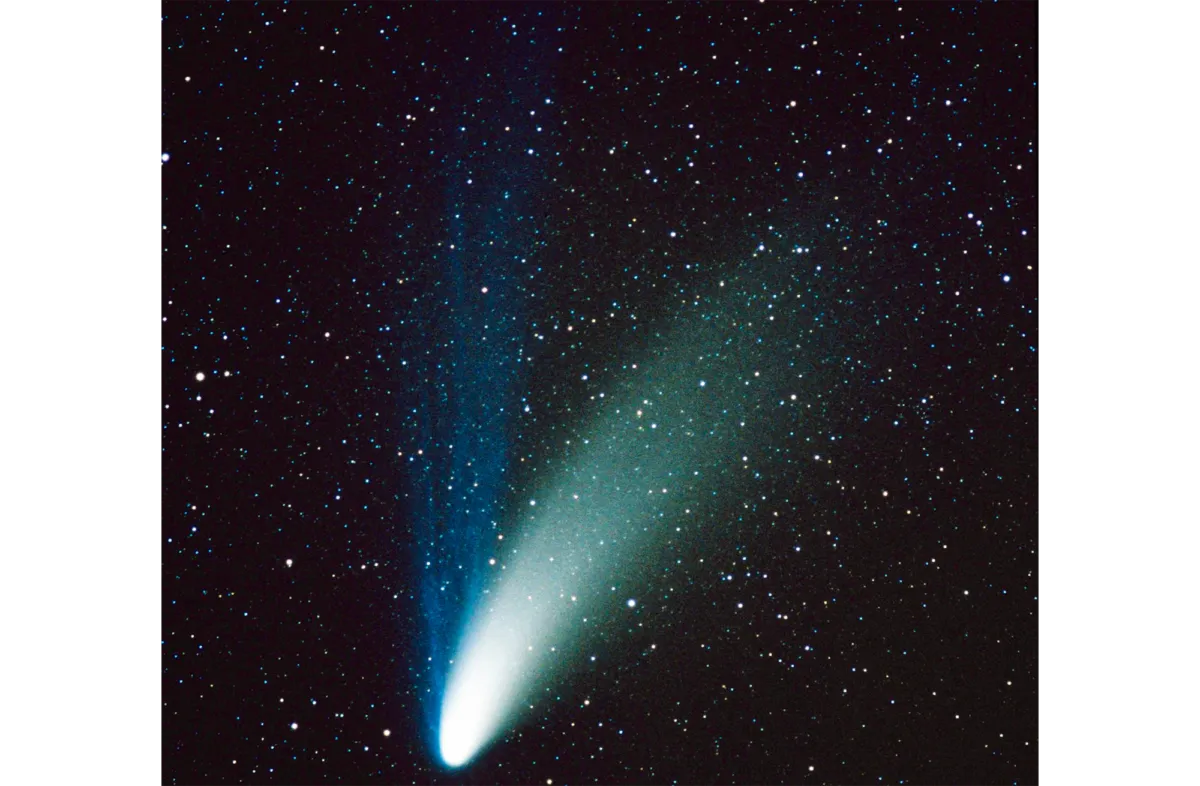This month, July 2025, marks the 30th anniversary of the discovery of Comet Hale-Bopp, the last truly 'Great Comet'.
That comet, discovered independently on 23 July 1995 by amateur astronomers Alan Hale and Thomas Bopp, was seen by millions of people around the world in the spring of 1997.
Discover more about comets

Although some comets have come close, we haven’t seen anything quite like it since.
But Hale-Bopp wasn’t the only bright comet of the late 1990s. Almost exactly a year before Hale-Bopp graced our spring skies, another comet was dazzling observers: Comet Hyakutake.

Comet Hyakutake discovery
Formally known as C/1996 B2, Comet Hyakutake was discovered on 30 January 1996 by an amateur Japanese astronomer named Yuji Hyakutake.
Unlike other comet hunters who used telescopes, Hyakutake used a pair of powerful 25x150 binoculars to sweep the sky above Kagoshima Prefecture in Japan.
He had already discovered a comet – Comet Hyakutake 2 (C/1995 Y1) – only a month earlier, but his second discovery was to prove far more exciting and important.
When discovered, Hyakutake’s second comet was just an 11th-magnitude smudge.
But when the numbers were crunched, it became apparent that just a couple of months later it would pass extremely close to Earth, coming within around only 0.1 astronomical units (AU) of our planet.
That's roughly 15 million kilometres (9.3 million miles). This made it one of the closest cometary approaches in the past 200 years.

The prospect of this close fly-by was exciting, because it meant the comet had the potential to be bright enough to be easily visible to the naked eye.
And the geometry of its close encounter with Earth meant it would move swiftly across the sky, possibly sporting a long tail, too.
But it also meant the comet’s visit to our night skies would be fleeting.
It would be at its best for only a week or so before racing away from us, heading back out into the cold, dark depths of the Solar System.

Preparing to greet Hyakutake
Unlike Hale-Bopp, which observers had well over a year to prepare for, there was little time to ready people in advance for the appearance of Hyakutake with detailed observing guides and magazine articles with finder charts, etc.
Only amateur astronomers with a working knowledge of the sky and access to the internet – which was still in its infancy then – knew it was coming and where to look for it when it arrived.
When it was shining at its best, the comet was featured on TV weather forecasts and in newspapers, but sadly, unlike Hale-Bopp, Hyakutake came and went, unseen by many people.

What it looked like
But those who did see Comet Hyakutake were entranced by it.
Although it never became as bright as Hale-Bopp, at its best, Hyakutake reached zero magnitude, still easily visible to the naked eye.
Its star-like head was a striking blue-green colour, and although it only had one tail, compared to Hale-Bopp’s famous two, Hyakutake’s tail was one of the longest ever seen in the sky.
In fact, as it passed the Pole Star, some observers reported being able to trace Hyakutake’s tail for almost 100 degrees – that’s the length of four Big Dippers, or the distance between Capella and Arcturus.
Many observers compared the tail to a 'search beam in the sky', and I’d agree with that.

I had my best view of Comet Hyakutake from the middle of the dark Cumbrian countryside in the UK, undimmed by light pollution.
The tail was so long and bright that at first, I thought I was seeing the beam of a car headlight shining up from behind a hill through a gap in the clouds.
But as the clouds parted, the comet was revealed in all its glory, its lavender-hued tail stretching out an astonishing length across the sky – a sight I’ll never forget.
So although it’s important to fondly remember Hale-Bopp, it’s equally important to pay tribute to Hyakutake, too.
It was much more than simply Hale-Bopp’s 'warm-up act'.
It helped amateur astronomers prepare for the arrival of that Great Comet and get the most from it when it was at its best the following year.

Comet Hyakutake vs Hale-Bopp
The nucleus of Comet Hyakutake was estimated to be approximately 4.2 kilometers (2.6 miles) in diameter, which is pretty average for a comet.
In contrast, the nucleus of Hale-Bopp was around 30 kilometers (18.6 miles), making it a true monster of a comet.
Comet Hyakutake’s orbit is highly elliptical, stretching out into the Oort Cloud.
It isn’t expected to return to the inner Solar System – and our skies – for another 98,000 years.
Hale-Bopp’s orbit is much less elliptical, and it will be in our night skies again much sooner, in the year 4385.
If you have memories or images of either comet Hyakutake of Hale-Bopp, we'd love to hear from you! Email us via contactus@skyatnightmagazine.com
